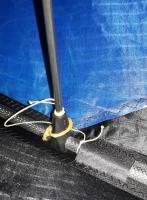-
Posts
580 -
Joined
-
Last visited
-
Days Won
27
Content Type
Profiles
Forums
Gallery
Downloads
KL Shop
Blogs
Articles
Everything posted by Exult
-
Came across a video about fighter kites in Brazil: “Global knowledge”… not where I come from 🙂 . At least for me the video made it easier to picture your concerns about avoiding the fighter kites.
-
Shoot! - I mean congratulations @edub, but please understand/forgive me – almost all of my quad line sets are now quite worn/high friction.
-
-
Oberg? - Any Swedish ancestry (Öberg is a not very unusual Swedish surname)?
-
So with this nice video, what is your current focus? What barriers are you aiming at breaking through. From where (videos, people, kite models, text/posts) have you lately gotten now input? Have you had any “knots” (i.e. difficulties) that have been undone or any new insights lately? Any new projects (like a turn, style, trick etc…)? Sorry for my “kite personal” questions!
-
High pace, precision and flow (unless, of course, you do sudden starts/stops)! Inspirational! - I want to go out for another session (and I have already managed to have two (quick) sessions earlier today).
-
I have never heard of the need of such (fighter kite dodging) considerations. A new perspective - thank you! (OK a bit late to this topic b.t.w. …). Your ideas and what you are prepared to do to handle this are also ”up-lifting” to read (OK I can’t switch my pun-radar off, but this was only passively generated 🙂 ). Good that you seem to have found places for kiting now (in your previous post). But still if you want to got to those riskier areas here is my contribution: Use short lines below 15m or so that you can land the kite quickly if any fighter kite would approach. To transport longer kite spars without revealing it, would it be possible to hide it among some (long) fishing gear or gardening equipment? Spars could be taped to a rake or perhaps inside a hollow shaft? 6km line + tail(s) carried by a 70cm kite? I don’t know much about fighter kites at all (not even about SLKs either), but I wonder if something happened here during some unit conversion or so? But on the other hand it is only one line and with a very thin line perhaps? Hmm… The rather strong sewing thread is used in the mini model speed wing project ( https://kitelife.com/forum/topic/8756-a-first-model-kite-probing-the-kite-building-ground/?do=findComment&comment=70689 ), was a #60/3 polyester thread. This means (if using this thread here) that the mass of 60m tread would be 1g and the mass of 6km is 100g (3.5oz) – only like a bar of chocolate! That should work (but that line would be very flexible I suppose)? Spiderkite Smithi Pro is a small quad line foil kite and doesn’t pull very much. Can fly in quite light wind and also fly backwards. Where I live grown up people in general don’t pilot kites. I think what people imagine is the toy kite from the local petrol station. In general they don’t know about high quality controllable kites and haven’t seen one being well piloted either. OK, our situations (and focus on kiting) are certainly different, but still my recommendation is: Don’t care about other peoples ideas/opinions so much here.
-
May I ask details about how the “rough handling of the tube” happened (so that it hopefully can be avoided) – A hard landing/crash or an off field incident like damage from closing a car trunk door? I have attached all four stand offs to the battens using pieces of old kite lines. When disassembling and before rolling the kite up I make sure that the stand-offs are parallel to the battens, either by using constantly on small rubber bands or fitting them into the pockets that holds the battens to the sail. I have previously lost (and then manufactured) one pair of battens (belonging to my Fazer XL) and then decided that I never would need to do this again. So therefore I attach smallish objects like this to the kite whenever there is a possibility to do so. May I again ask for a favour by asking for details here as well? A Rev 1.5 std can with a bit of effort be used indoors. Only one time have I tried to use the Fulcrum (with the light frame in) indoors. I could only keep the Fulcrum in the air by running around in a kind of survival mode – no up and overs possible. However this was just on one occasion and the technique could be likely be improved. But no, not really, I believe that the fundamental difference in sail shape makes it impossible to use the full area at the same time as an efficient wing. With a Rev/Hadzicki-wing it is possible by design, and therefore the zero/low wind properties of a rev will always be better if properly piloted. Though I’d appreciate if someone could prove me wrong here actually.
-
I agree when it comes to the side slides, especially upwards vertically – you simply don’t come very high up in the wind window with the Fulcrum. However I do not agree when it comes to the axels. The Fulcrum (with its 3D sail) is forgiving when doing e.g. (quad) axels - it will not fall out of the sky on slack lines or hardly ever get tangled even when provoked. I was soon axel cascading at a time when I could hardly do one axel on a rev. You can even do DLK-like half axels with most of the feeling preserved. If trying to to do the corresponding thing with a 1.5 rev it is more like you emulate it needing to help it all the way through the DLK half axle imitation. Flipping it (as in part of a flic-flac), turtle and flaring it etc is not easy for me – have only more or less accidentally managed it a few times, but then I can’t flic-flac a rev yet. On the other hand, in light wind, a DLK-like pop-up launch (which involves some flipping) is quite easy to do (if you are used to do it with DLKs at least I suppose). Losing track of what was LE and TE occasionally happened during the first few sessions, but that problem disappeared after 5-10 sessions or so.
-
I’m sorry to hear that, but no this kite is an item of affection for me and is connected to a certain phase of life (and transition to another). Since this was the first ”real” kite (and at the time the main among few kites) it has taken much beating and has had much of the parts replaced with what parts that were available. In addition to the previously repaired sail damages (one was actually so large that I could crawl through the hole) there is also a more ”recent” rip (that needs to be repaired) through two panels where they connect to the dacron. It is simply the most worn kite that I got. If you want something similar (at least in appearance, I have never tested one so I can’t say anything about the properties) you could go for a Skydog Jammin’ ( http://www.skydogkites.com/stuntkites/jammin.shtml ). It should be by the same designer, Dodd Gross, as the Jam Session (was Christoph Fokken also involved in Jam Session?), but certainly of a later model. If your husbands mobility is an issue and he happens to know how to control a rev-like quad line kite, it could be an alternative to a dual line kite. Quad line kites can be flown with less footwork. Whatever you decides, good luck to the most possible extent given you situation.
-
I stick to them as well, but actually I meant more of evolving by learning to deal with the kite and adopt to it. Take the three kites I referred to in my post above as an example: The HQ Maestro felt funny initially, but paved the way to to my deserted island DLK, the HQ Infinity. Before I was more familiar with older types of kites. The HQ Jam session felt “at home” and I had similar feelings for the Prism Elixir. Not being used to smallish low wind kites, the Prism 4D didn’t feel as a real kite for the first ten sessions. I’m sure that a similar (size/wind range) kite also could have provided that. Before the 4D I was very dependent of the larger inertia of “normal” standard wind range larger kites. The 4D was a medicine against the tendency I had from the Jam Session days to do tricking with a flick like input. The Rev Indoor felt like (and was) a total failure – constant unintended ground contact (*). I put it away for (one, two years was it?) after about five sessions. Since I returned to the Rev Indoor soon 3/4 years ago, it has provided: Much improved use of heavy brake (in normal flight) in no/low wind (and feeling of pressure) allowing the kite to do most of the work instead of you (and I thought that I already knew this from before…), not being so dependent on a soft LE in low wind to propel the kite and offering a (third**) flavour of quad axel practice... * The feeling is like a caricature of piloting a bridle-less 1.5 quad. ** The other flavours of axel practice I tested are 1.5 Revs and the “toss around forgiving” Skyburner Fulcrum.
-
I like this way of seeing it – i.e. the last word, the “yet”. Accept ten sessions of “Meeeehhhh…, what is this kind of kite??” or perhaps you need to put it away for a year until ones skills in some area slowly “unlocks” the kite. I have had three instances of kites whose properties that were so different from what I was used to, that it took time before I accepted them, but having gone through that process these three have have all been rewarding in teaching me new distinct aspects. Yes the ITW Hydra (in addition the the three above mentioned) also felt a little peculiar to begin with, though I didn’t dislike it at any point. It felt a bit sensitive and didn’t hold the turtles/back flips well (I guess this when well controlled could be a feature). The Hydra also turned out to be rewarding. It got me starting with the axel cascade, since it didn’t end up on its back after a few cycles. Having the “Hydra axel cascade” I could then work on axel cascades of other kites that demanded a small pull on the lower wing before the major pop on the top wing.
-
Or whatever that happens to be available. In a similar situation where the ground was frozen and was too hard to drive the kite stake (screwdriver) into, the weight of the backpack turned out to be sufficient to hold the handles. If you use the tow bar of someone's car at the parking as a temporary handle anchor point, make sure that the car will not suddenly drive away. 🙂
-
I’d say it is mostly originating from people in general not knowing: what it is, what kites can offer and do. But with this ”setting of reality” it becomes an exercise in not caring about what others think. This also applies on the field – to learn something new you need to accept to fail, most often in public, since a kite is very visible. This view is actually a bit odd considering that you are probably the the most skilled person when it comes to kites on that beach or that field. Personally, my QLK low/zero wind development was delayed by this (and that is truly stupid). Totally agree! Not having to: charge the kite, regularly update it, fear stop receiving the updates, stop being able to see it well in day light, accept that you can't repair it or need keeping it from water is a luxury! If having only one DLK, the first thing (before considering a certain a brand) I’d think of is what wind range I’d like to cover when purchasing the next one. Then try to figure out which model that could offer you that wind range and other desirable properties. Also from the manufacturers video ( https://www.youtube.com/watch?v=qC0dU6Wp5zY ) the possible tricks with this model should keep ”a total newbie” occupied for a long time (I have never started learning the comet btw). Don’t underestimate the time it takes learning a new trick until you can claim it (but do enjoy the trip!). Now I certainly don’t say don’t go for that second kite. They all have different properties that provide food for thought and affect the direction of your kiting. Typically (talking for myself at least) learn a slack line trick (or turn, or landing/start...) on one kite (that is more prone to do it) and then transfer it to another model. Also if having a 2m span kite, after a while it is not surprising if one would get curious of a more full size one. As you seem to realize, this second kite could lead to another kite and then another… Good luck with your development!
-
> With absolutely no help from my able assistant. I think that even if the cat would be in the way lying on the ripstop, consider it a success if it keeps its claws in. > I tried to fly in the backyard and had moderate success with the light wind glider kite … …I’m sure the neighbors found it amusing watching me stumble around the backyard with a kite string in one hand and a cell phone in the other. Working at home most of the days I often use the low morning and evening wind on the sheltered parking close to my home. This wind is quite free from turbulence and quite suitable for my Rev Indoor and B-series std sometimes. And yes of course it is an odd activity that no one else is doing here and is fully visible by the neighbours and other people passing. There are few pandemic related mandatory restrictions here so I could go to a field or the beach if I wanted to, but the parking just happens to be so close.
-
I think that the very process of announcing and sharing what one is doing (as you do here) puts some kind of pressure to finish whatever project that is ongoing. Good luck with your kite making!
-
Really, I’m quite eager to get this one, to close the circle. I started out years ago with the conviction: -”Naah, QLKs are for others - I’m a DLKer only”. OK, tried QLKs and “got stuck” there for soon three years now, but for a long time thought that zero wind was not for mortals. Then I got properly started with indoor/zero wind piloting about half a year ago, still sticking to QLKs. While keeping a zero/low wind focus (the available nearby parking makes this kind of a natural choice) a return to DLKs could be through the Kaiju (which will obviously arrive here in Northern Europe any time soon b.t.w. 🙂 ).
-
Trimming the nose towards you or away from you angle by changing the attachments points of the lines on the bridle e.g., affects how easily the kite turns/rotates for a certain input when pulling one of the lines e.g.. Trimming the kite so that the nose gets further away from you makes the kite turn more easily. It also makes it easier to maintain a stall. The ease of maintaining the stalls by nose away trim is valid to a certain point when the kite gets too prone to sink while stalled, especially towards the edges of the wind window. When overdoing the nose away from you, the kite might also be difficult to start from the ground. Except for the very lightest winds (when maintaining a stall is not so much of a problem anyway), try to trim the kite nose away until you start to miss the forward drive. Now much less input to the snap stall is required and maintaining the stall is easier. That should enable you to do the snap stall (or anything else that involves a stall) with more control. Play with the trimming until you get an idea of how it works. If not well marked, make sure that there is a way to return to the initial trimming first. In the Prism videos (from about the same time as the @Dodd Gross HQ VHS cassettes ( had them all)) I remember that they recommended to do the two inputs of the snap stall very quickly. There Mark Reed snapped his left and right hand fingers (representing the right/left tugs on the lines during a snap stall) with less and less time between until you hardly heard that there were two individual snaps any longer. Perhaps this soon input of the second tug could stop the kite from over rotating? OK, to the over rotating spin stalls… hmm… can’t think of something else than stop the turning input (the pulling on the line that makes the kite spin) a bit earlier.
-
-
Yes, that a good one, especially the part about tension. Start practising on paper until you get it right and then on a patch of ripstop. I leave no guarantees whether paper will eventually make the needle go blunt or not. However I have done rather much paper sewing stitch practice and then checked the needle tip in a microscope by comparing it to other needle tips without seeing any bad effects. Here is the same document in two other addresses: https://web.archive.org/web/20180524030645/http://dako-club.tripod.com/kitesewing101.htm https://sites.google.com/site/kites4all/home/kite-sewing-101
-
Actually, when thinking about it, I have had more kiting opportunities now than during normal times. While working from home most of the days I don’t spend the time travelling home in the dusk (when the wind typically drops to an acceptable level). In this lighter wind I can now go to the (no lights really) parking in the dusk (with the neon yellow reflex west on). For longer line (solo) kiting I see in principal no difference now from before in the number of opportunities. OK, time disappears due to additional activities related to the new situation, like: preparation of DIY hand/phone sanitizer, stream line cleaning routine, agreeing to what extent we should go on with activities that carries some risk, driving children so that they don't need to go by public transportation, how we would split the home (using plastic foil and splitting up the food storage...) in case one of us got infected, extra shopping for the mother in law, minimizing normal non-covid19 risks to avoid unnecessary exposure...).
-
I have stopped doing indoors QLK indoors, but outdoors in zero wind instead. I have postponed to start doing it in more densely populated spaces (which was something I aimed for) in case someone would have spat on the ground etc., but I do it on a sparsely used parking when the conditions allow it. Otherwise when using long lines on a field or a beach (especially on this time of the year) I feel safe, since it should be ideal from a Covid-19 perspective I guess.
-
Sounds great. Feel free to contact me in advance to make it easier to plan. Low/zero wind outdoors on short lines and indoors are not very different from each other and can be performed with a Rev std (though you need to move your feet more in zero wind compared to a Rev Indoor). A key thing is to apply enough brake when the wing is in normal flight forwards, so that pressure is maximized and required number of steps are minimized IMO (also pulling in the direction of the lines is important). That being said I have not been doing short line zero/low wind piloting regularly for more than say five months.
-
Hello and Welcome! It is not every day you learn about some person that can pilot a QLK or DLK in Sweden! I do quads (and duals only occasionally nowadays) and like to discuss the various aspects thereof. I practice all year-round at least weekly with outdoor and/or indoor quads. However I do not live close to Kalmar, but in Stockholm. If you would happen to pass Stockholm it would be fun to do some common (during these unfortunate times: outdoors only) kiting. On Gärdet (large field in Stockholm) perhaps? Unfortunately I don’t think that there is such a thing as a Swedish club for duals or quads here. I have never seen/heard of any Swede now actively doing quads than @Anders Matson (west coast of Sweden). Last year @Axident (doing quads I believe) put his marker in Malmö (see https://kitelife.com/forum/membermap/ ). However the four line Orao kite is marketed in a department store chain in a few places, so there could be more persons active (though I have never seen one being piloted).
-
15m lines (49’) often requires me to do a little backwards jogging when doing throws. I can’t recall that the 8.2m lines (27’) were more difficult for me when learning catch&throws. With shorter lines there is less walking involved and therefore more time for the catches and throws practice. Mix and try different line lengths – testing something new tends to make one learn something new. Good luck!








